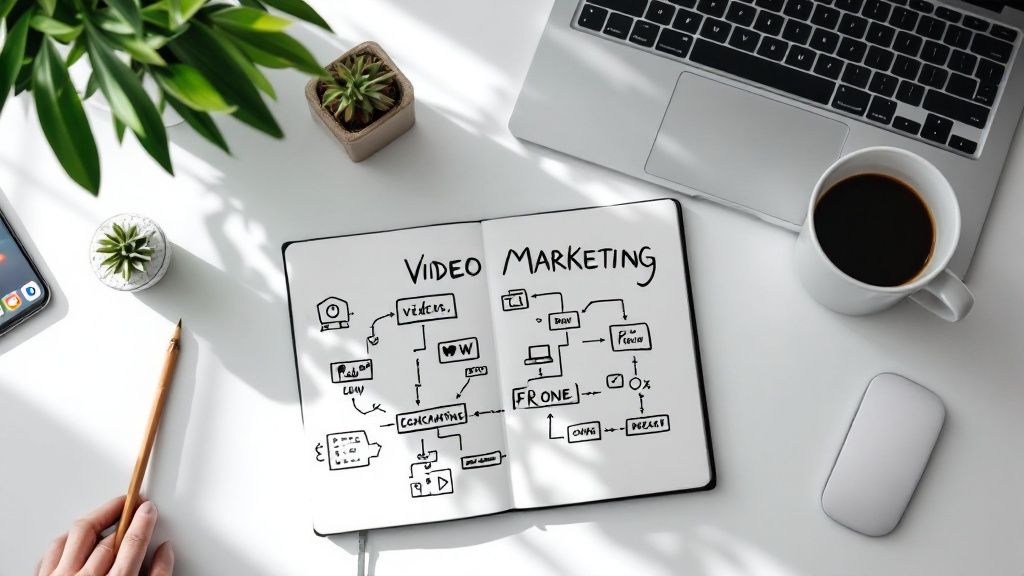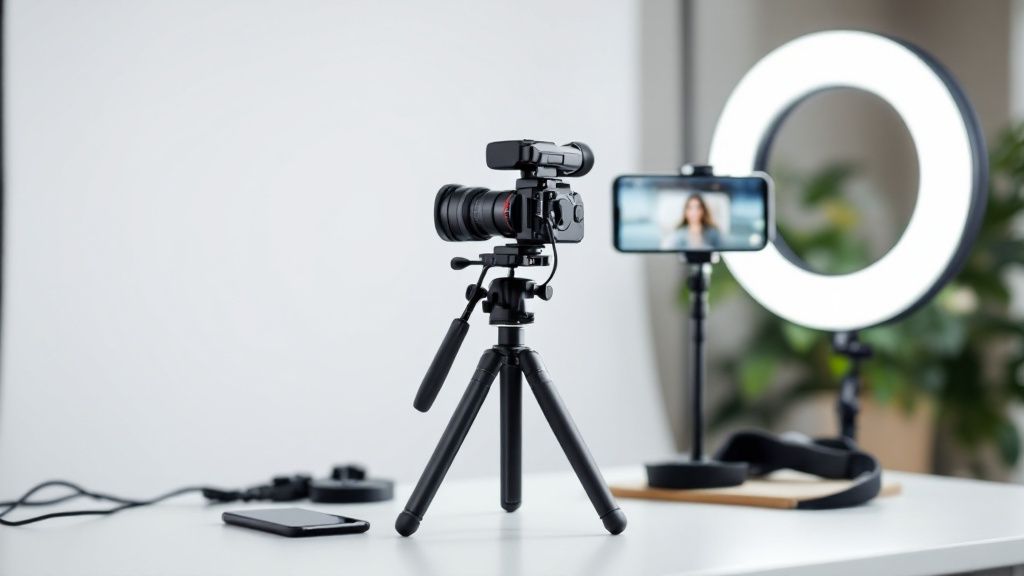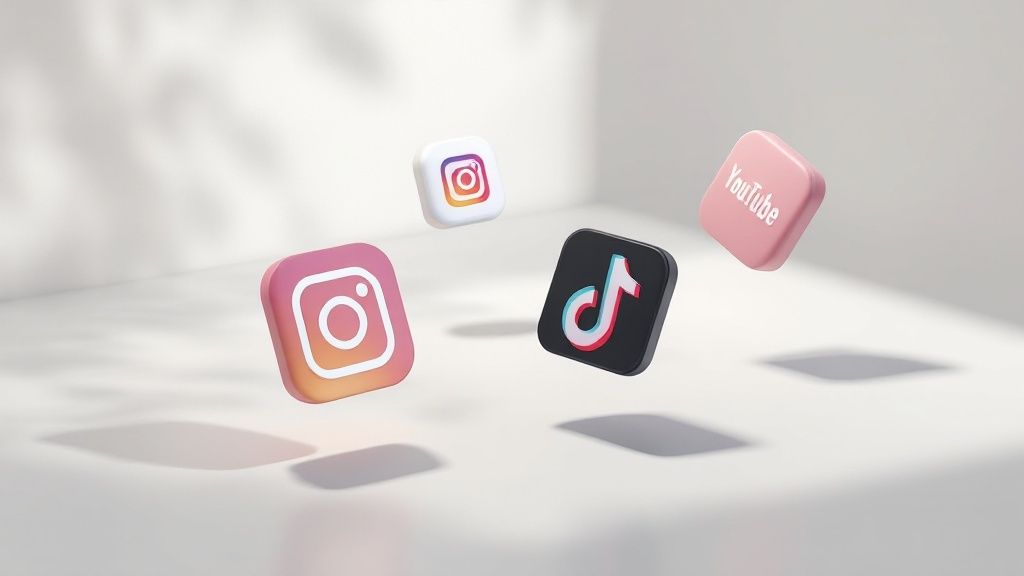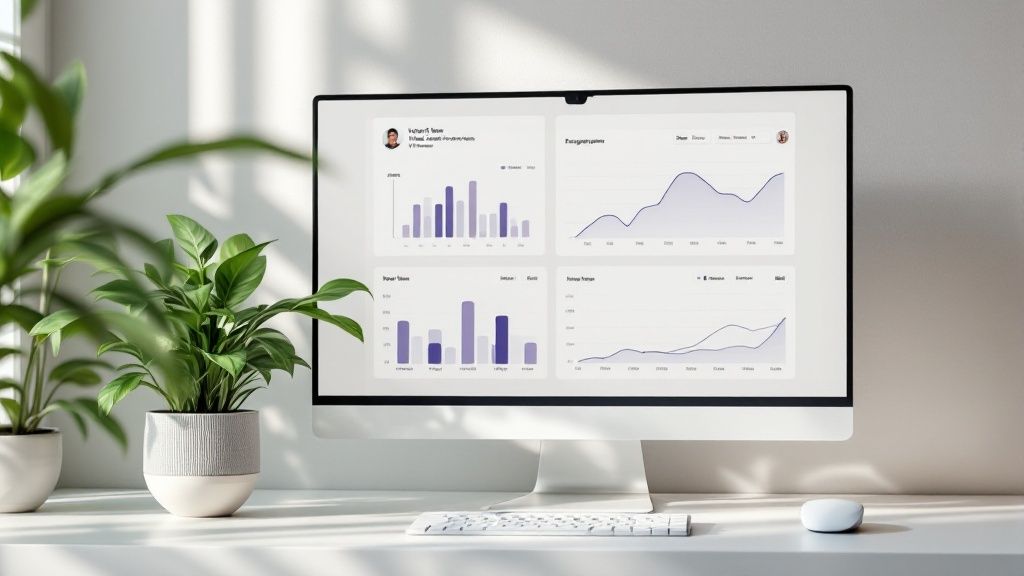Let’s picture a scenario you might know all too well. Your marketing team just pushed a beautifully designed static post to all your social channels. You spent hours on the copy, the graphic is pixel-perfect, and you’ve hit all the brand guidelines. You wait. A few likes trickle in. A comment from a bot. Then… silence. The engagement plateau. It feels like you’re shouting into a void, and the algorithm has simply decided to look the other way.
This is the exact moment where a strategic shift to video marketing doesn’t just offer a solution—it changes the entire game. It’s a move away from broadcasting static messages and toward building real, dynamic connections. Imagine transforming that silent feed into a vibrant conversation, turning passive scrollers into an engaged community. This isn’t about just swapping a photo for a moving image; it’s about adopting a playbook of creative video strategies designed for the fast-paced, human-centric world of social media.
This guide is that playbook. Forget rigid tutorials. We’ll walk through the creative approaches that help brands cut through the noise, build genuine authenticity, and drive results on platforms from TikTok to LinkedIn.
Why Your Social Media Strategy Needs a Video-First Makeover
Think about your own scrolling habits. What makes you pause your thumb mid-swipe? It’s rarely a static image. It’s motion, a human face, a story unfolding in a few seconds. Video grabs our attention because it mirrors real-life interaction. A static image captures a single moment, but a video tells a story, sparks emotion, and creates a far more memorable experience.
Switching to a video-first strategy means you stop asking, “What photo should we post?” and start asking, “What story can we tell?” This simple change opens up a world of creative possibilities. Instead of just showing your product, you can show how it’s made, who made it, and the problem it solves for a real person. This transition is crucial for brand survival and growth.
The benefits of making this shift are clear and almost immediate:
- Sky-High Engagement: Videos naturally get more likes, comments, and shares than static posts. It’s just how the platforms are built.
- Real Authenticity: Behind-the-scenes clips, team member spotlights, and live streams help humanize your brand and build trust.
- Better Storytelling: Video lets you weave richer narratives that can explain complex ideas or build a strong emotional connection with your audience.
By embracing video, you’re not just feeding the algorithm; you’re building a community. You can dive deeper into the core reasons for adopting this approach by exploring our guide on why you should use video for marketing. Consider it your playbook for moving beyond the engagement plateau and into a new era of genuine connection.
Mastering Short-Form Video for Maximum Impact

Short-form video absolutely dominates the social feed, but real success isn’t about awkwardly hopping on the latest dance trend. It’s about packing a strategic punch into just a few seconds. Think of it as a creative puzzle: how do you deliver value, show your brand’s personality, and spark a connection before your viewer’s thumb even thinks about swiping away?
The key is crafting snackable content built for instant impact and shareability. This isn’t just a phase. With videos under 60 seconds being absolute gold for grabbing attention, you have less than three seconds to make that first impression count.
Proven Formats That Actually Cut Through the Noise
To make every second matter, you need a playbook of formats that consistently get results. These aren’t rigid rules, just creative frameworks you can mold to your brand’s voice.
Here are a few formats that work wonders:
- Quick Problem-Solution Clips: Pinpoint a common pain point your audience has and show exactly how your product or service solves it. This approach is direct, valuable, and instantly relatable.
- Trending Audio Skits: Don’t just slap a trending sound on a random video. Weave it into a story that showcases your brand’s personality. It proves you understand the platform’s culture while still being you.
- Bite-Sized Tutorials: Break down something complex into a few simple, visual steps. These “micro-learning” moments position you as the expert and give your audience something they can actually use.
- Rapid-Fire Showcases: Ditch the slow, boring product tour. Use quick cuts and energetic transitions to show off multiple products or features in a way that’s visually exciting.
When you get comfortable with these formats, you build a versatile toolkit for your video marketing for social media campaigns. For more platform-specific ideas, check out our guide on how to make standout Instagram videos.
The goal isn’t just to be seen; it’s to be remembered. Short-form video achieves this by delivering a concentrated dose of value or entertainment that sticks with the viewer long after they’ve scrolled past.
Let’s Get Real: Humanizing Your Brand Through Storytelling

In a social media feed packed with polished ads, being real is your biggest advantage. People don’t just buy products anymore; they buy into the stories and the people behind the brand. This is your chance to pull back the curtain, show the human side of your business, and turn passive followers into a genuine community.
Two of the most powerful ways to do this are through behind-the-scenes (BTS) content and the raw, unfiltered energy of live streaming. It’s time to forget about being perfect and start being real.
Pulling Back the Corporate Curtain with Behind-the-Scenes Video
Behind-the-scenes content is your golden ticket to showing the heart and soul of your operation. It’s how you go from being a faceless logo to a group of passionate people. But a standard, boring office tour won’t cut it.
Here are a few BTS ideas that actually work:
- ‘Day-in-the-Life’ Team Takeovers: Give the social media keys to a different team member each week. Let them show their real routine—from their morning coffee ritual to the big project they’re wrestling with.
- The ‘How It’s Made’ Journey: Take your audience along for the ride as your product comes to life. Show the raw materials, the messy early prototypes, and even the moments when things go wrong.
- The Unfiltered Blooper Reel: Perfection is dull. A well-timed blooper reel can be incredibly endearing, showing you don’t take yourselves too seriously.
Behind-the-scenes video marketing isn’t just about showing what you do; it’s about showing who you are. Every raw, unscripted moment builds another layer of trust with your audience.
The Raw Power of Live Streaming for Authenticity
If BTS content pulls back the curtain, live video rips it down completely. There’s almost nothing more authentic than a live stream where anything can happen. That immediacy creates a powerful sense of connection and FOMO (fear of missing out), making viewers feel like they’re part of an exclusive event.
Think about trying one of these high-impact live stream ideas:
- Founder Q&A Sessions: Host a live Q&A on Instagram with your company’s founder. Let your audience ask anything.
- Expert Panel Discussions: Use a platform like LinkedIn Live to host a panel discussion with other industry thought leaders.
- Live Product Demos or Workshops: Instead of just telling people how your product works, show them and answer questions in real-time.
Both BTS and live video are about shifting from broadcasting at your audience to engaging with them. You’re inviting them into your world, and it’s that feeling of inclusion that transforms casual followers into passionate advocates.
Turning Viewers Into Advocates with Community-Driven Video

So far, we’ve been talking about creating video content that speaks to your audience. Now, let’s flip the script and start creating with them. This is how you turn passive viewers into passionate brand advocates—people who don’t just watch your content, but help you make it. The strongest marketing doesn’t come from your brand; it comes from your customers.
Launching User-Generated Video Campaigns to Build Trust
Imagine your best customers becoming your most effective marketers. That’s the magic of user-generated video content (UGC). It’s authentic, trustworthy, and engaging because it comes from real people sharing real experiences. A simple hashtag contest is a good start, but the best campaigns tap into something deeper.
Try launching a story-sharing initiative. Instead of just asking for a product review, ask your community to share a video showing how your brand fits into their lives. A camera company could ask for videos of “your most unforgettable moment.” This approach helps you build an emotional library of content that resonates on a human level.
The Underrated Power of Personalized Video Messages
While UGC helps scale your reach, personalized video is what deepens individual relationships. In a world of automated DMs, a one-to-one video message can create an unforgettable brand experience.
Think about the impact of sending a quick, 15-second video to a new follower, welcoming them by name. Or imagine a loyal customer getting a personal video from your team after their tenth purchase, just to say thanks.
This might seem unscalable at first, but its impact on word-of-mouth marketing is massive. A single personalized video can turn a happy customer into a lifelong advocate.
These tiny interactions build what I call a “community flywheel.” Every positive, personal touch fuels more loyalty, which in turn inspires more user-generated content and positive buzz. It’s a self-sustaining cycle of advocacy.
Scaling Your Video Content Machine Without Burning Out

The constant demand for fresh video can feel like running on a content hamster wheel. You post a great Reel, and then almost immediately, the algorithm is hungry for more. The escape route isn’t about working harder—it’s about working smarter. You need a system that lets you pump out a high volume of content without sacrificing quality or sanity.
The Pillar Content Strategy: Repurposing Like a Pro
A game-changing approach is the “pillar content” strategy. Instead of brainstorming a new idea for every single post, you start by creating one substantial, long-form piece of video—like a webinar, an in-depth tutorial, or a podcast interview.
This single “pillar” becomes the foundation for dozens of smaller, native social media clips. It’s a ‘create once, distribute everywhere’ model.
Here’s how it breaks down:
- The Webinar: That 45-minute webinar can be sliced into five to seven insightful micro-videos for LinkedIn.
- The Tutorial: A 10-minute YouTube tutorial can be turned into a series of 60-second Reels, each demonstrating a single step.
- The Interview: A 30-minute podcast can provide countless quote graphics, audiograms, and short video clips of the most compelling moments.
This repurposing model ensures you always have a backlog of valuable content ready to go, dramatically reducing the pressure to create something new from scratch every single day. For a deeper dive, explore creating engaging social media content that connects.
Embracing Automation for Consistency and Scale
Repurposing your pillar content is a huge step forward, but what about keeping a consistent presence and adding those personalized touches? Manual creation will only get you so far. This is where automated video content becomes your most valuable ally.
Using templates and automation allows teams to produce consistent, on-brand videos without starting from a blank slate every time. It’s the key to scaling effectively while maintaining quality.
Video automation is the bridge between a high-frequency posting schedule and high-quality, relevant content. It allows you to generate data-driven videos tailored to specific audience segments without endless hours of manual editing.
With an automated system in place, you can ensure every platform has a steady stream of engaging content, keeping your audience hooked while freeing up your team for bigger strategic initiatives. This is how you finally step off the hamster wheel and start building a true content machine. Solutions like Wideo’s video automation solution are designed to help companies achieve this scale.
Common Questions About Social Media Video Marketing
Jumping into social media video can feel like a big leap, and you’ve probably got questions. From budgets to video length, let’s clear up some of the common concerns that trip up marketers. My goal is to give you the clarity—and confidence—to build a video strategy that actually gets results.
How Long Should My Videos Be?
The honest answer? It depends on the platform and your audience’s mindset. You wouldn’t bring a feature-length film to a TikTok party. Match the energy of the platform.
Here are some solid rules of thumb:
- TikTok & Instagram Reels: Keep it snappy—15 to 60 seconds is the sweet spot. Hook them in the first three seconds flat.
- LinkedIn & Facebook Feed: You have more breathing room here. Videos between 1 to 2 minutes tend to do well for quick tips or customer stories.
- YouTube (Shorts vs. Long-Form): Shorts are under 60 seconds. Standard videos can range from 5 to 15 minutes if the content is genuinely valuable enough to hold attention.
The real secret isn’t about hitting a specific second count. It’s about earning the viewer’s time. Respect their time, and they’ll pay attention.
Do I Need a Big Budget and Fancy Equipment?
Let me debunk this one right now: absolutely not. This is probably the single biggest myth that holds people back from creating video.
These days, authenticity often wins out over slick, high-production value. That smartphone in your pocket? It’s more than powerful enough to shoot incredible video for social media.
Instead of dropping cash on expensive cameras, focus your resources where they really matter:
- Good Audio: People will forgive shaky video, but they will click away instantly for bad audio. A simple lavalier mic is a game-changer.
- Simple Lighting: No need for a pro lighting kit. Just find a window. Natural light is your best friend.
- A Clear Story: A great idea with a solid script will always outperform a boring story shot with Hollywood-grade gear.
Honestly, that scrappy, behind-the-scenes feel often builds more trust and relatability anyway. Don’t let a “lack of budget” be your excuse for not starting. Getting the technical specs right is also important; for ads, make sure you’re using the essential Facebook ad sizes so your content looks crisp.
How Do I Measure the ROI of My Videos?
Measuring the real return on your video efforts means looking past the vanity metrics. Likes and views are nice, but they don’t pay the bills. You need to connect video performance to actual business goals.
First, define what success looks like for each video. Are you trying to build brand awareness, capture leads, or drive sales?
Once you have your objective, you can focus on the KPIs that matter.
| Goal | Key Metrics to Track | Why It Matters |
|---|---|---|
| Brand Awareness | Views, Impressions, Reach, Shares | This is all about eyeballs and spreading the word. |
| Audience Engagement | Comments, Saves, Watch Time, Completion Rate | This tells you if your video actually connected with people. |
| Lead Generation | Click-Through Rate (CTR), Landing Page Views, Form Fills | Is your video actually pushing viewers to take the next step? |
| Sales | Conversion Rate, Revenue from Tracked Links | The bottom-line metric that ties views to revenue. |
Use unique UTM parameters in any link you share with your videos. This is how you track exactly how much traffic—and revenue—a specific video is generating. When you focus on these business-centric numbers, proving the value of your video marketing becomes a whole lot easier.






